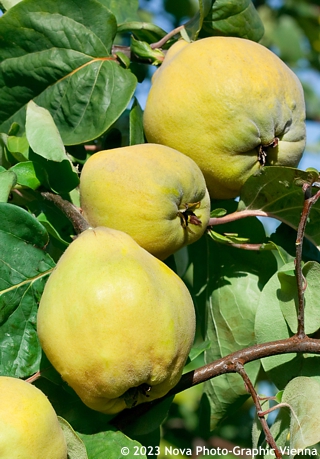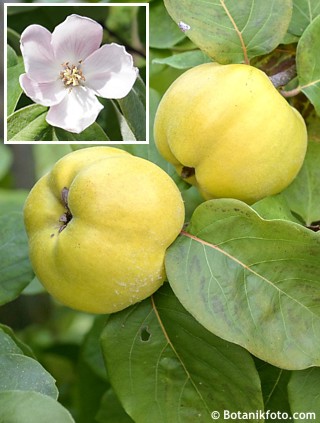
Cydonia oblonga 'REA'S MAMMOTH' quince
size/type
small tree,taller shrub
usual height
2-5m
usual width
2-3m
leaves
deciduous broadleaf
colour of leaves
flowers
less showy but noticeable
colour of flowers
blooming time
May
location
full sun
soil type
any (acidic to alkaline)
soil moisture requirements
evenly moist but well-drained
USDA zone (lowest)
5 (down to -29°C)
winter protection
for zone 5+6

for zone 7

categorized
Quince is an old-fashioned fruit species that is re-gaining well-deserved attention again. In ancient times the fruit was also called golden apple. It comes from West Asia and is scarcely distributed across temperate parts of the world including hotter regions because it is both hardy and heat resistant. There is a number of varieties boasting various fruit shapes, maturity time, and habits, however, not always is this tree cultivated solely for its tasty and good-looking fruit. Its leaves as well as foliage are handsome, too.
Description of the plant:
Rea‘s Mammoth is an American variety of quince developed by Joseph Rea from Coxsackie, NY, and registered in 1895. It produces very large, chubby oblong-shaped fruit that is rich yellow when ripe and highly aromatic. Its diameter is 8-10 cm and each fruit weighs 500-600 g. Quince is renowned for its large, pink flushed, white flowers, which come out later in the season when the tree already has leaves. Those are deciduous, oval, 5-10 cm long or exceptionally longer, rich green in summer and golden and orange in autumn with prominent red veins and stalks. Quince naturally forms a large, spreading shrub but can be trained into a single-stemmed tree or grafted. It is self-fertile but cross-pollination will considerably increase yield.All quince varieties are cultivated for the strongly aromatic fruit which is picked in late autumn, usually in October in temperate regions of Europe. In countries with hot and long summers it is left on the tree until it turns soft which is a sign of maturity, only then it is very aromatic and sweet. Here (C.E. climate) the fruit is commonly processed as it is used to enhance aroma of desserts, preserves and other meals with different types of scent-lacking fruit. It has high content of potassium and vitamin C, sugars are on the same level as in apples, for instance.
Quince is soil adaptable, however, if you are looking for heavy crop of quality fruit make sure the soil is well-drained, medium moist, and rich in organic matter. Grow it as a compact shrub or small tree in full sun or some shade, it will not tolerate deep shade. Pruning time and style are identical to what you do with apples – remove unwanted or ill branches in late winter. Hard pruning is also done in winter, just bear in mind such tree will not flower or fruit that year. Alternatively, you can shear it after flowering if you need to reduce its size, this way you will still have at least some fruit from the inner unpruned branches. Hardy to about -30 °C.
Last update 16-11-2023














